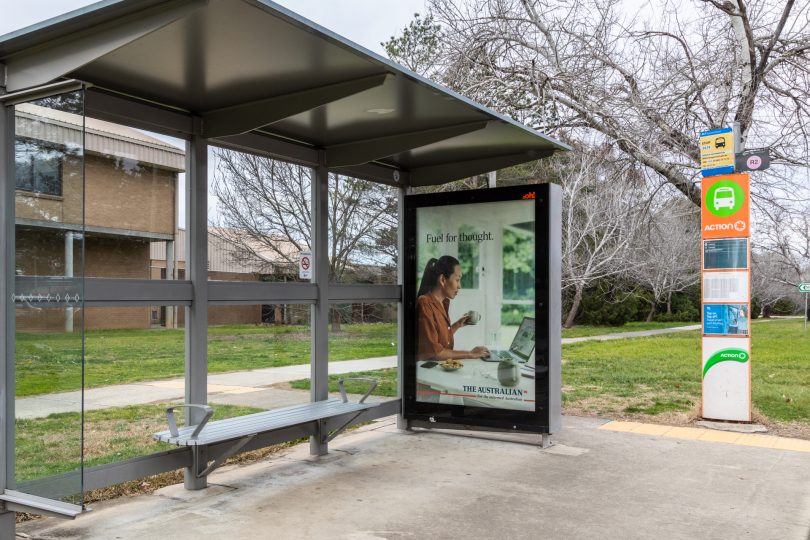
Greens Senate candidate Tim Hollo and ACT Greens crossbencher Jo Clay in front of a pop-up art installation they say could be put in place of public advertising. Photo: Lottie Twyford.
Advertising is everywhere – on our television screens, on social media, on our phones, our laptops, it’s riding past on buses and cars and staring down at us from buildings. But a longstanding ban, in place since the ’30s on billboards in the ACT, has helped keep our streets cleaner and less cluttered than other major capitals around the world.
That means most ads seen by Canberrans are either wrapped around buses, on bus shelters, or private buildings (if approved during the development process).
But the Greens say there’s another kind of advertising – of the illegal variety – proliferating around the bush capital’s nature strips and roadsides and they want it gone.
ACT crossbencher Jo Clay has tabled a petition in the ACT Legislative Assembly on behalf of Federal Greens candidate Tim Hollo calling on the government to clamp down on all existing illegal advertisements – whether they are found on business walls, inside public transport, on the roadside, or anywhere else.
One ad which has particularly concerned her is a Cash Converters ad encouraging young people to take out a loan so they can purchase fast food.
Her petition also asked the government to introduce specific offences for roadside advertising using parked vehicles and to review and update the rules for what advertising content is allowed on public transport, and apply these rules to bus and tram shelters, as well as vehicles.

The ACT Greens have long been opposed to advertising in public spaces. Photo: Michelle Kroll.
The petition also calls for the government to get rid of bus shelter ads by not renewing the Adshel contract.
Currently, ads are allowed in Canberra bus shelters under an exemption in the National Capital Plan.
In the long run, the petitioners would like to see the Assembly undertake consultation on community support for replacing all public transport advertisements with locally commissioned artwork, given advertising revenue contributes to only 0.6 per cent of the cost of Transport Canberra’s operations.
The petition was signed by more than 500 Canberrans.
But Minister for City Services Chris Steel described calls to further tighten already strict public advertising laws as “out of touch”, given it would impact revenue.
“We know that people in the seat of Canberra really care about better public transport, not cutting this vital service,” he said.
The debate around public advertising occurs regularly in the ACT.
In 2016, Chief Minister Andrew Barr suggested that a limited amount of digital display advertising might serve to mitigate the proliferation of illegally placed billboards on vehicles parked on roadsides.
Two years later, the government again flagged a potential relaxation of the current rules but an inquiry into the matter received record opposition from the community, including from the ‘Keep Canberra Ad Free’ campaign – of which Mr Hollo was a coordinator.
Last year, Mr Hollo raised a similar petition with the ACT Government.
The ACT Greens have long been opposed to roadside corflute advertising during election campaigns and refrained from using them in the 2020 election.
This year, there’s a campaign gathering steam to replace the illegal ads with art when they are taken down.
Local artist John Voir had a pop-up work installed in Civic Square to show how “art is advertising for the things we need’, unlike advertising, which shows people the things they don’t need.
“The pop-up will be a digital collage representing reclaimed advertising spaces in the Canberra landscape,” Mr Voir said.
“The installation shows how reclaiming spaces currently occupied by advertising enriches the existing landscape of Canberra, rather than mortgaging its beauty to businesses.”
















